

WARNING! The Sun is extremely dangerous. Looking at it
with any sort of optical aid will result in instant blindness.
Look here to
see how I do it.
The Sun was due to reach its minimum activity in 2007, and I took only one picture that year, and two in 2008. The cycles are only 11 years on average and this cycle seems to be dragging on a bit. There has been a tiny spot at high latitude and one at the opposite magnetic polarity, both of which indicate the start of a new cycle, but there have been no significant spots.
Move your mouse over the pictures below to see the number designations of the spots. This also shows just how few there have been.
|
Sunspot Designations |
Sunspots and Active Regions are numbered by the American National Oceanic and Atmospheric Administration (NOAA) and started on 5th January 1972. These numbers now exceed 10000 but often the leading "10" is omitted. The designations of current sunspots can be found on the SOHO site. A most useful archive of diagrams of the Sun showing the positions and designations of sunspots on a daily basis right back to January 1992 is available from The Institute for Astronomy, University of Hawaii. This link will take you to their archive page from where you can select a given image by date or browse by month. I find this particularly useful if I have imaged an interesting spot after some days of cloud, and I can look back and see when the spot appeared. |
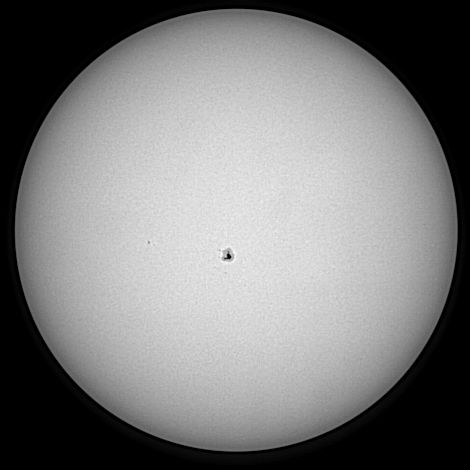
|
I only took this one picture in 2007. The spot was small but I wanted to try different filters. The quality was quite different but I'm not convinced that factors other than the filters were not contributing to the final results (focus for example), so I present here only the best pictures. This one of the whole Sun was taken through an OIII filter (Astronomik). (I did of course also use the full-aperture solar filter to remove 99.99999% of the light.) Date and Time: 1 May 2007, 10:11 UT Camera: Atik 1-HS Telescope: 270mm SLR lens Capture: K3CCDTools. Low gamma, 1/50", 22% gain, 498 frames Processing: Registax. 498 frames stacked. Wavelets 1 = 10, 2 = 5, gamma 1.2, histogram 0-195 |
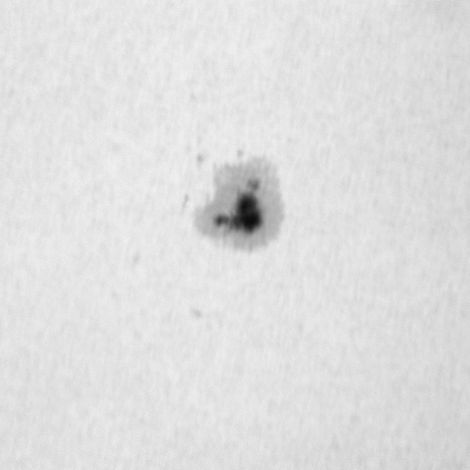 |
Close-up of spot number 10953, taken with an Astronomik Hα filter. (Note that this is a broad-band Hα filter used for pictures of emission nebulae, not the very narrow-band filter used for showing prominences and the like.) Date and Time: 1 May 2007, 10:55 UT Camera: Atik 1-HS Telescope: ETX125 at prime focus Capture: K3CCDTools. Low gamma, 1/50", 5% gain, 610 frames Processing: Registax. 495 frames stacked. Wavelets 1,2 = 10, gamma 1.3, histogram 60-195 |
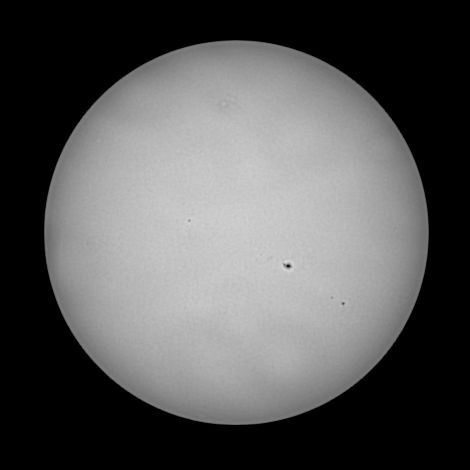 |
A little string of small spots appeared in March 2008. It is not obvious in the picture, but these are all close to the Sun's equator, so these belong to the old cycle, not the new. Cycles can overlap, so the presence of this spot does not conflict with the tiny spots that may have been of the new cycle. Date and Time: 30th March 2008 12:15 UT Camera: Atik 1-HS Telescope: 270mm SLR lens at f11 Capture: K3CCDTools. Low gamma, 1/100", 0% gain, 1090 frames Processing: Registax. 942 frames stacked. Wavelets 1,2 = 10 Gamma 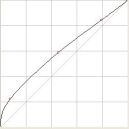 |
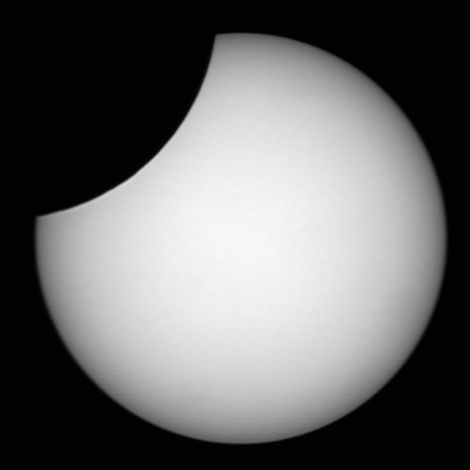 |
On 1st August 2008 there was a partial eclipse of the Sun visible from the UK. This picture was taken about 10 minutes after the maximum phase. Move your mouse over the image to see the first glimpse I had of the eclipse. Date and Time: 1st August 2008 09:33 UT Camera: Toucam 740K Telescope: 270mm SLR lens at f11 Capture: K3CCDTools. Low gamma, auto exposure, 377 frames Processing: Registax. 279 frames stacked (50 seconds between the clouds!). Histogram 0-177 Mouseover picture: Date and Time: 1st August 2008 09:11 UT Camera: Olympus 5050 and fl 21.3, 1/800" exposure at f/8 |
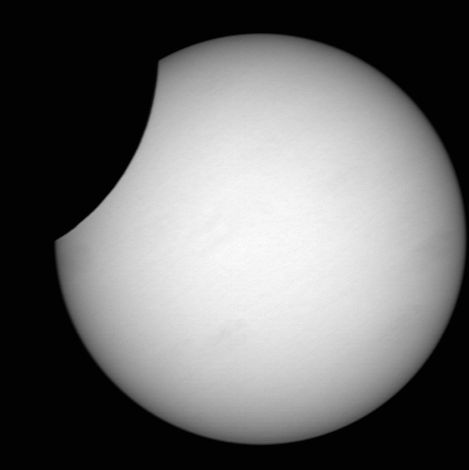 |
The only other reasonable picture of the eclipse, taken at 09:50 UT through a 25-second gap in the clouds. The mouseover picture shows the sort of thing that happens with 90% cloud cover. This lovely bit of open sky (the clouds were moving right to left) missed the Sun by about 10°. Date and Time: 1st August 2008 09:50 UT Camera: Toucam 740K Telescope: 270mm SLR lens at f11 Capture: K3CCDTools. Low gamma, 1/250", 15% gain, 271 frames Processing: Registax. 126 frames stacked. Histogram 0-150 Mouseover picture: Date and Time: 1st August 2008 09:14 UT Camera: Olympus 5050 and fl 21.3, 1/800" exposure at f/8 |